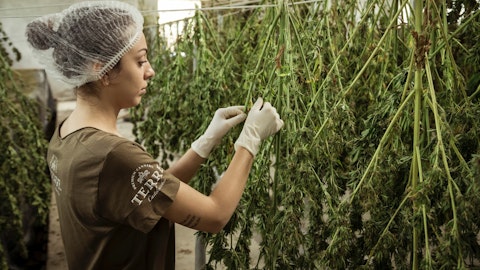Leafly Holdings, Inc. (NASDAQ:LFLY) Q4 2023 Earnings Call Transcript March 28, 2024
Leafly Holdings, Inc. beats earnings expectations. Reported EPS is $-0.22, expectations were $-1.41. Leafly Holdings, Inc. isn’t one of the 30 most popular stocks among hedge funds at the end of the third quarter (see the details here).
Operator: Good afternoon. Thank you for attending today’s Leafly Fourth Quarter 2023 Earnings Call. My name is Tamia, and I will be your moderator for today’s call. I would now like to pass the conference over to your host, Josh deBerge with Leafly. You may proceed.
Josh deBerge: Good afternoon, and welcome to Leafly’s Full Year 2023 and Q4 2023 Earnings Call. Joining me on the call today are CEO, Yoko Miyashita, and CFO, Suresh Krishnaswamy. Today’s prepared remarks have been recorded. A copy of our press release can be found on our website at investor.leafly.com. Today’s call will contain forward-looking statements, which are made pursuant to the safe harbor provisions of the Private Securities Litigation Reform Act of 1995. Forward-looking statements include statements regarding the services offered by Leafly, the markets in which Leafly operates, business strategies, performance metrics, industry environment, potential growth opportunities and Leafly’s projected future results and financial outlook, and can be identified by words such as expect, anticipate, intend, plan, believe, seek or will.

These statements reflect our views as of today only, should not be relied upon as representing our views at any subsequent date, and we do not undertake any duty to update these statements. Forward-looking statements by their nature address matters that are subject to risks and uncertainties that could cause actual results to differ materially from expectations, and we caution you not to place undue reliance on such statements. For a discussion of the material risks and other important factors that could affect our actual results, please refer to the risks discussed in today’s press release, our 2022 annual report on Form 10-K filed with the SEC on March 29, 2023, and our other periodic filings with the SEC. During the call, we will also discuss non-GAAP financial measures, which are not prepared in accordance with generally accepted accounting principles.
A reconciliation of the GAAP and non-GAAP result is included in our earnings press release, which has been filed with the SEC and is also available on our website at investor.leafly.com. We’ve changed the format of our call, and rather than doing a live Q&A, we have some submitted questions that we will answer at the end of this call. With that, let me turn the call over to Yoko.
Yoko Miyashita: Good afternoon, everyone. 2023 was a turbulent year across the cannabis industry. In the midst of macroeconomic and industry-wide headwinds, Leafly’s attention has been on improving our efficiency as a business, which we believe strengthens our path to profitability while continuing to deliver value for our partners. We’ve focused on building a more durable business and also work to grow our relationships with high-value partners, ensuring they get the most out of the Leafly platform by engaging with the tools we offer. We continue to enhance our consumer experience through improvements to some of our most important features like deals functionality, delivery offerings and search capabilities, and are making it easier for retailers to work with Leafly to reach the cannabis engaged consumers they are after.
See also 12 Best Places to Retire in Idaho and 12 Best Places to Retire in Bali.
Q&A Session
Follow Leafly Holdings Inc.
Follow Leafly Holdings Inc.
Q4 revenue was above our guidance at $9.75 million. Our adjusted EBITDA was positive $1.16 million, an improvement from negative $231,000 in Q3 and benefited from the reversal of bonus accruals. Cash, a crucial focus area for us, saw an uptick, finishing the year at $15.3 million, an increase of 5.7% quarter-over-quarter. According to a Whitney Economics report from June of 2023, less than 25% of the cannabis sector is profitable, reflecting the challenging operating conditions for retailers and brands. Those conditions impacted our business, and as a result, nonpaying customers reached a high point for us in Q3, which we recognized was unsustainable. We strategically focused on collections throughout Q4 and we made difficult decisions to continue removing underperforming and nonpaying retailers.
Proactively terminating relationships with these partners was a tough but necessary step to get us to a durable and healthier base of customers. Ending retail accounts at year-end were 4,075, a 30% reduction year-over-year and an 8.8% decline quarter-over-quarter. As part of our efforts to understand trends, we’ve performed a deep dive into many of those lost accounts to gain insights into why they left the platform. Using that data, we are surfacing valuable insights to inform a more tailored approach to reactivation when it makes sense, offering pricing that we believe better aligns with individual retailer needs and budgets. With this more thoughtful approach, we expect fewer accounts churning for nonpayment or delinquency as the worst offenders are removed.
And we expect to see better alignment, reacquiring customers to the right product at the right price to build a stickier, more durable retailer base. As we’ve shifted the composition of our retailer base, we’ve also bolstered our sales team, recently hiring 6 new market managers and 2 new acquisition managers who will be intently focused on improving penetration in key markets and going after new market opportunities. Our augmented sales team is focused on adding to our base of paying retail subscribers. To aid the team in doing that effectively in a challenging market, we plan to introduce price points and products for everyone who wants to be on our platform at any level of engagement, and better demonstrate and convey the power and value of our platform to our retail customers.
We recently collaborated with a digital technology platform to measure online and offline purchases at a retail store chain in California. We tracked the consumer journey from learning about cannabis products on Leafly to purchase. This attribution data shows what we long believed, that Leafly plays a critical role in the consumer purchasing journey regardless of whether they ultimately place an order on Leafly. This retail store chain saw their return on spend nearly double when factoring in the full influence of our platform, including research and discovery. We’re on a continuous path of reducing retailer friction and enhancing the consumer experience, and we introduced a number of improvements, some incremental, some significant, across the platform.
In Q4, we rolled out more widely our order API, which reduces integration time and complexity and provides a more seamless experience, allowing retailers to receive Leafly orders in their POS and fulfill them for shoppers from the systems retail staff used in store. We also introduced new deal types and improved the deal engine that powers them. New deal types increases the volume and variety of deals in our marketplace. This is essential because it helps consumers find the best prices near them. The deals engine improvements reduced the time and effort for retailers to load new deals. That’s important because consumers are searching for the best prices at a time when their own wallets are under pressure. Cannabis discovery remains core to who we are and what we do.
Consumers continue to rely on Leafly to research, learn about and ultimately decide what cannabis is right for them. Over our decade-plus history of helping consumers discover cannabis, we have developed a unique and proprietary data set, which is helping power our prototype AI Budtender. We continue to refine the learning model with our first-party data. We look forward to sharing more about this prototype later this year and how it should enhance the user experience across the Leafly platform. AI is just one example of an area our product team is working on, and we’ll continue to seek out strategic opportunities to invest in our product in meaningful ways. Our focus over this year, however, will be centered on improving our existing products and services with a focus on delivering value for the retailers, brands and consumers we serve.
As we look ahead, we see potential bright spots, including the anticipated rescheduling of cannabis by the DEA this year. This could provide extra cash flow for cannabis businesses as they shed the heavy tax burden of 280E under the federal tax code. Rescheduling should have a positive impact on the industry as a whole, potentially driving additional marketing spend from retailers and brands and encouraging the deployment of additional capital into the sector. And while we look forward to federal reform, we see the state-by-state legalization movement continue, which helps progress Leafly’s business. We saw good growth in the markets that launched recreational sales in 2023. In Missouri, which started rec sales in February last year, we nearly doubled revenue in 2023 compared to 2022.
And in Maryland, we saw a 27% increase in monthly revenue in the months after recreational sales started in July. New state markets will come online in the fall of this year, including Ohio, which became the 24th state to legalize adult recreational use. Ohio’s medical market cannabis sales topped nearly $500 million in 2023 across 120 dispensaries, and many believe it has the potential to be a $1 billion-plus market when rec matures. We’re already in the Ohio market in front of consumers and existing licensees and are excited to help them capitalize on legal recreational sales. Total penetration across the state could represent a sizable revenue opportunity just by using our current ARPA rates. Overseas, on April 1, we will excitedly watch as Germany legalizes adult-use cannabis.
That’s legalization momentum is going global. Legalization moments like these fuel industry momentum and further normalize cannabis. Over time, this industry will continue to grow, and we’ll continue using the powerful platform we’ve built to serve high-value consumers looking for trusted and premium content and connecting them with local retailers and brands. I’ll now turn the call over to Suresh.
Suresh Krishnaswamy: Thank you, Yoko, and welcome, everyone. In the fourth quarter, our revenue was $9.7 million, down 19.5% year-over-year and down 8% sequentially. Fourth quarter retail revenue was $8.3 million and brand revenue was $1.4 million. As we discussed on our last quarterly call, retail accounts continued to decline as we made the decision to remove accounts for nonpayment, and we saw a further tightening of retail customer budgets. Ending retail accounts in Q4 were 4,075 compared to 4,466 at the end of the third quarter. The 391 account decline in Q4 represented about half of the decline we saw in Q3. We have seen a further moderation in the rate of decline so far in Q1 and have worked through the bulk of the backlog to remove nonpaying accounts.
Looking ahead, with our investments in new sales heads, we’re focused on adding accounts. As Yoko mentioned, with our refined product offering, we can provide solutions for every type of customer at price points to match their desired level of engagement. Our retail ARPA in Q4 was up 21% year-over-year to $672. The increase can be attributed to the removal of nonpaying accounts, which tend to be longer tail smaller retailers with lower ARPA. Based on what we’re seeing so far in the first quarter, ARPA is beginning to stabilize, and we don’t expect ARPA to move significantly from this level over the short term. Brand revenue was up 6.2% sequentially in Q4 to $1.4 million, largely due to the stronger holiday season. We mentioned last quarter that brand revenue seemed to be leveling out.
As a reminder, we had stronger brand revenue in the first half of 2023, but saw a softer second half as brands pulled back on spend. So far, Q1 ’24 has remained at the softer level from the second half of last year. We continue to remain cautious in the outlook for this part of the business. Continuing down the financial statement, our total gross margin in the fourth quarter improved to 89.2% compared to 88% a year earlier primarily due to headcount reductions implemented in the first quarter of ’23 and reviews business platform costs. For operating expenses, Q4 totaled $8.6 million, down 48% year-over-year. We continue to focus on cost savings, streamlining our business, while also investing in areas with the greatest potential for growth.
At the end of 2023, we had 131 employees, down 36% year-over-year. Revenue per employee in Q4 was around $74,000, a 25% increase year-over-year. During the first quarter of 2024, we eliminated a handful of positions in our marketing and content departments. At the same time, we added 8 new sales people to aid with top line growth and make a push for new business. The net 6 headcount reductions will result in savings of approximately $1 million annually. Importantly, over the last 6 months, we have streamlined our sales operations. Part of this work included reducing costs in the sales organization by outsourcing administrative work. This change allows our sales team to focus more on customer engagement. Our focus on cost containment over the last 12 months has helped move Leafly closer to sustainable operating profitability.
We were successful in taking $25 million in costs out of the business during 2023. As a result, our full year adjusted EBITDA was negative $2.3 million compared to negative $23.2 million in 2022. For the fourth quarter, adjusted EBITDA totaled $1.2 million, which was above the guidance we provided of negative $1.3 million. Before turning to the balance sheet, I’d like to call out the progress we’ve made with collections and nonpaying accounts. As we mentioned on our last earnings call, we’ve been very proactive in implementing tighter processes for managing bad debt. As a result, we did see our bad debt expense as a percentage of revenue move lower from 8.9% in Q3 to 4.3% in Q4, and are pleased with the progress we’ve made in this area. We see some signs of stability around the 6.5% average for 2023 as we enter 2024 with tighter collections processes and are focused on further improvements over the rest of the year.
Now to the balance sheet. We ended the quarter with $15.3 million in cash, excluding restricted cash, as we continue to prioritize cash collection and preservation. We are expecting our cash burn in Q1 to be around $1.5 million, which includes a $1.2 million interest payment on our convertible notes. Now a note on our going concern qualification. Before I discuss our outlook, as you may have seen in our press release today, we expect to have a going concern qualification in the audit opinion in our 2023 financial statements in our 2023 10-K. This is due to our $29.7 million convertible notes coming due in January 2025, and based on our current liquidity position, our inability to repay the notes when due. Resolving this issue is an important priority for us.
In Q4, we began exploring opportunities to address the upcoming maturity of the notes. For example, in December 2023, we worked with our noteholders and converted a small portion of the outstanding principal to equity. We continue to evaluate all of our options, and we’ll let you know when we have more information to share. I also wanted to provide an update on our NASDAQ listing status. When we file our 2023 10-K, based on our audited financial statements, we will no longer qualify for listing under NASDAQ’s continued listing standards, including the net income standard under which we had previously qualified. We expect to receive a notification of noncompliance from NASDAQ within days of filing our 10-K. We are evaluating and pursuing available options that could allow Leafly to remain on the exchange.
And I want to reiterate that we are laser-focused on the top line as well as in addressing our balance sheet and reducing our operating cash burn. We believe this focus on operations and revenue can position Leafly for stronger outcomes across a variety of scenarios. Now to our guidance. For Q1 ’24, we expect revenue of around $9 million and an adjusted EBITDA loss of approximately negative $1 million. It continues to be a difficult environment for cannabis. We took measures we believe have rightsized the business and continue to focus on operational efficiency. We’ve also added new sales resources to invest in growing the top line in the areas that we expect hold greater opportunity. And we’re prudently managing our balance sheet and exploring all options on the capital front that are intended to set us up for success as we move forward.
We’ve received some questions over the quarter in our IR inbox, and I’ll now turn the call back to Josh to take us through some of those.
A – Josh deBerge: Thanks, Suresh. The first question we have, are there any updates on your Board vacancies?
Yoko Miyashita: Thanks, Josh. As we just announced a few moments ago, Jeffrey Monat and Andres Nannetti were elected to our Board of Directors and appointed to the Board’s Audit Committee. We’re excited about the experience both of these individuals bring to the table and are looking forward to working with them to build Leafly’s business. We also believe their appointments to our Audit Committee put us back into compliance with NASDAQ’s Audit Committee composition requirements, and we’re expecting to receive confirmation from NASDAQ in the coming days.
Josh deBerge: The next question is about our billing terms and nonpaying customers. What are Leafly’s average terms? And how are you addressing the nonpaying customer issues?
Suresh Krishnaswamy: Let me take that, Josh. Over the last 9 months, we have tightened our collections policies and processes. We worked through the bulk of the nonpaying customers and removed them from the platform and believe we’re in a much better position today. Around 60% of our revenue is automatically charged by credit card or ACH at the start of a billing period. Our largest accounts are on net 30-day terms, with all others due upon receipt. Our collections process involves proactively reaching out to customers with reminders as soon as 3 days overdue, with regular outreach through their eventual exit from the platform in the event of nonpayment.
Josh deBerge: Our next question, what should be expected for cash burn for the full year?
Suresh Krishnaswamy: We’ve continued to reduce our cash burn, and it remains an important priority for us. In Q1, we’re expecting around $1.5 million of cash burn, which includes an interest payment of $1.2 million on our convertible note. We’re working to manage our quarterly cash burn to maintain or improve from this level over the rest of the year.
Josh deBerge: And the final question, what is Leafly doing to improve company performance?
Yoko Miyashita: Thanks for that. So Leafly came hard at work addressing the headwinds we are facing in this industry. We can’t change the lack of access to capital for cannabis businesses. We can’t change the fact that retailers are going out of business or can’t pay their bills. But what we are doing is focusing on the things we can control as we seek to reverse our negative revenue trend. We’re managing the business with an emphasis on efficiency and deepening relationships with our financially sound customers to set us up for success as we move forward. I want to thank you for your continued interest in and support of Leafly. We appreciate your time today, and we look forward to keeping you updated on our operations and progress. Thank you.
Operator: This concludes the Leafly Fourth Quarter 2023 Earnings Call. Thank you for your participation. You may now disconnect your line.



